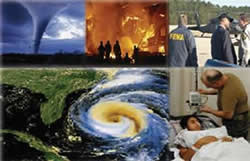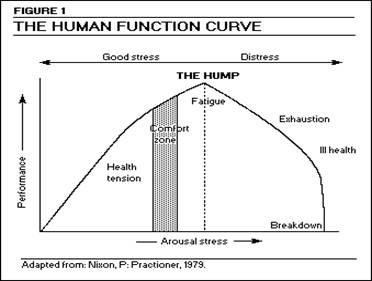Public Safety
Disaster-Related Stress: A Primer for Public Safety Personnel 
The immediate response to events such as disasters is stress. Stress is an elevation in a person's state of arousal or readiness, caused by some stimulus or demand. As stress arousal increases, health and performance actually improve. Within manageable levels, stress can help sharpen our attention and mobilize our bodies to cope with threatening situations. As the following graph illustrates, “optimal” stress involving functional amounts of arousal contributes to effective task performance, including response to disaster.
 But beyond that optimal level there is deterioration of health and performance begins to lessen, so it is important to manage stress in order to keep it in the “good” range.
But beyond that optimal level there is deterioration of health and performance begins to lessen, so it is important to manage stress in order to keep it in the “good” range.
Stress is mediated by appraisal which is the process of threat-assessment and response-formulation that your brain carries out when you are confronted with potentially harmful environmental challenges: “Have I had this experience before? If so, how did I respond? What was the outcome? Can I cope with the situation now?” If there's doubt as to any of these questions, the stress response elevates.
Here are some common stress reactions in response to disasters, experienced to varying degrees by everyone involved with them, and which you will experience as well.
Symptoms of stress that may be experienced during or after a traumatic incident |
Physical* |
Cognitive |
Emotional** |
Behavioral |
Chest pain* |
Confusion |
Anxiety |
Intense anger |
*Seek medical attention immediately if you experience chest pain, difficulty breathing, severe pain, or symptoms of shock (shallow breathing, rapid or weak pulse, nausea, shivering, pale and moist skin, mental confusion, and dilated pupils). **Seek mental health support if your symptoms or distress continue for several weeks or interfere with your daily activities. |
- Monitor yourself and others for signs that you may need stress management assistance, if any of the following become persistent and extreme:
- Difficulty communicating thoughts
- Difficulty remembering instructions
- Difficulty maintaining balance
- Uncharacteristically argumentative
- Difficulty making decisions
- Limited attention span
- Unnecessary risk-taking
- Tremors/headaches/nausea
- Tunnel vision/muffled hearing
- Colds or flu-like symptoms.
- Disorientation or confusion
- Difficulty concentrating
- Loss of objectivity
- Easily frustrated
- Unable to engage in problem-solving
- Unable to let down when off duty
- Refusal to follow orders
- Refusal to leave the scene
- Increased use of drugs/alcohol
- Unusual clumsiness
- Practice self-care and coping for yourself.
- Be aware of more serious signs of stress in yourself and in your coworkers as they may indicate Post-Traumatic Stress Disorder:
- Intrusions, such as flashbacks or nightmares, where the traumatic event is re-experienced.
- Avoidance, when the person tries to reduce exposure to people or things that might bring on their intrusive symptoms.
- Physical signs of increased arousal, such as excessive/inappropriate vigilance (such as when there is clearly no need to be on your guard) or increased startle response.
Although the effects of PTSD are serious and difficult to deal with, it can be treated by a variety of forms of psychotherapy and medication.
Web Links
The homepage of the National Center for Posttraumatic Stress Disorder offers an abundance of educative resources that address some of the mental health concerns faced by public safety personnel.
Here is an article from the CDC for Stress Management for Emergency Responders What Team Leaders Can Do
Here are some specific techniques for individual stress management
This gives some of FEMA’s reccomendations for coping with disaster stress
